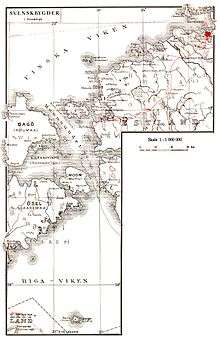Estonian Swedish
Estonian Swedish (Swedish: estlandssvenska) or Coastal Swedish (Estonian: rannarootsi keel) are the eastern varieties of Swedish that were spoken in the formerly Swedish-populated areas of Estonia (locally known as Aiboland) on the islands of Ormsö (Vormsi), Ösel (Saaremaa), Dagö (Hiiumaa) and Runö (Ruhnu), and the peninsula (former island) of Nuckö (Noarootsi), by the local Estonian Swedes.[2]
| Estonian Swedish | |
|---|---|
 Estonian Swedes on Ruhnu, 1937 | |
| Region | Estonia |
| Extinct | (date missing) |
Indo-European
| |
| Language codes | |
| ISO 639-3 | – |
| Glottolog | esto1259[1] |
Until the evacuation of the Estonian Swedes near the end of World War II, both Swedish and Estonian were commonly spoken on the named islands. It is not clear if there are any mother-tongue speakers left.[1] After Estonia's independence following the dissolution of the Soviet Union, Estonian Swedish experienced a revival, with courses in the language being offered on Dagö and Ösel.

Currently the number of native speakers is unknown but assumed to be low.[3]
Samples
Estonian Swedish comprises a number of sub-dialects, for example nuckömål and rågömål.
An example of the nuckömål dialect from the Nordisk familjebok, compared with standard modern Swedish:
- Stick tälknin i stolpan o hälvtor stolpan topa kalkan, säte Halmen o Hälma färe kalkan o ker te Nuckö toka.
Standard Swedish:
- Stick täljkniven i stolpen och vält stolpen på kälken, sätt Hjälmen och Hjälma för kälken och kör till Nuckö.
References
- Hammarström, Harald; Forkel, Robert; Haspelmath, Martin, eds. (2017). "Estonian Swedish". Glottolog 3.0. Jena, Germany: Max Planck Institute for the Science of Human History.
- "Svenska ortnamn i Estland - Institutet för de inhemska språken". Kotimaisten kielten keskus (in Swedish). Retrieved 2019-11-15.
- Rosenkvist, Henrik (2018). "Estlandssvenskans språkstruktur" [The linguistic structure of Estonian Swedish] (PDF) (in Swedish). University of Gothenburg. Retrieved 18 Jun 2020.